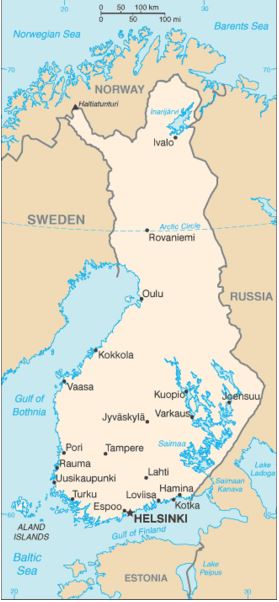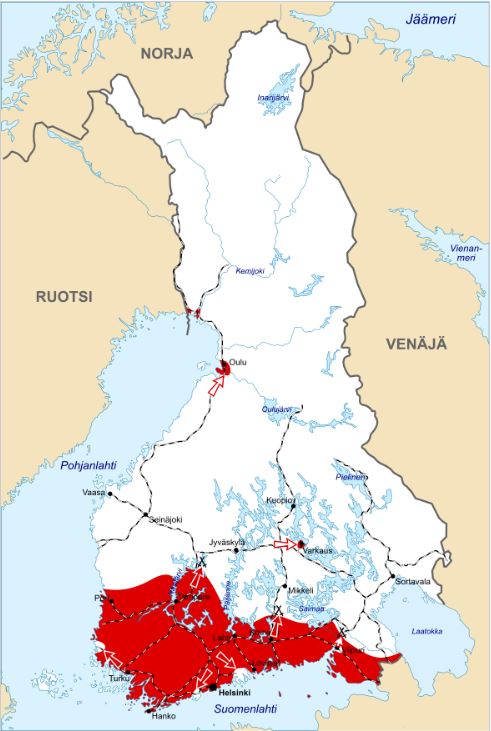Wars of Finland
Finland is a northern European nation that borders on both Sweden and Russia. At varying times in history, Finland has been ruled by both Sweden and Russia, but since independence in 1917, literally all of Finland’s wars have involved conflict with Russia/the Soviet Union (Russo-Finnish Wars).
Map courtesy of the CIA and WikiMedia
A list of Finnish Wars and major wars affecting Finland:
1200s-1809-Swedish Rule of Finland
Partial Russian occupation during the Great Northern War (1714-1721) and the Russo-Swedish War of 1741-1743. Following these wars, Finland reverted back to Swedish rule.
1808-1809- Russian conquest of Finland from Swedish rule during the Russo-Swedish War of 1808-1809. Also known as the Finnish War.
1809-1918-Finland is part of the Russian Empire.
Kagal Resistance Movement (1901- 1905 )- Organized resistance to Russian rule in Finland, as Russia attempted to suppress Finnish culture as part of a cultural “Russification” movement.
World War One– From 1916 to 1918, about 2,000 Finnish volunteers joined the German Army in a special “Jager Corps,” trained as elite commandos by the Germans. These Jagers fought against the Russians on Germany’s Eastern Front. When Finland declared independence, they returned to Finland and formed the core of the Finnish White Army in the Finnish Civil War. The term “Jager” is still used by the modern Finnish Army.
1917-1918-In the last year of World War One, Finland declared independence during the Russian Revolution/Russian Civil War. Following independence, Finland fell into civil war, with both Germany and Soviet Russia intervening. The Finnish Civil War is a part of World War One.
Finnish Civil War-1918-In the chaos of World War One, and the Russian Revolution, and the subsequent Russian Civil War, Finland declared independence from Russia in December, 1917. By January, 1918, Communist and non-Communist Finnish forces were battling each other for control of newly free Finland.
While the war only lasted about four months, it was a bitterly fought civil conflict between the conservative, non-Communist “Whites,” and the pro-Communist “Reds.” (The terms White and Red would be used in other European nations over the next several years as other nations engaged in civil wars and revolutions).
Both sides had significant support from other nations. Soviet Russia supplied weapons and some troops to the Finnish Reds, while Germany sent several thousand troops to aid the Whites. Several thousand Swedish volunteers also aided the Whites. The war ended with the Finnish White forces, along with the German army, defeating the Reds. Both sides conducted massacres and ill treatment of POWs, and the aftermath of this civil war negatively affected Finnish society for years.
The Finnish Civil War can be considered a part of World War One, the Russian Revolution, and the Russian Civil War.
Map courtesy of Wikipedia
Kindred Nations Wars/Heimosodat-During the chaos of the Russian Civil War (1918-1922), many ethnically non-Russian parts of the old Russian Empire attempted to break away to become independent nations, or to join with other nations. In the northern regions of Russia bordering the newly independent Finland, several wars and revolts took place by ethnic Finns living inside Russian territory, often with aid from Finnish military volunteers. These conflicts did not officially involve the new nation of Finland, but, had they succeeded, would have added land and people to Finland.
It should be noted that in Russian history, this period of conflict in the Russian-held regions bordering Finland, is considered as a Finnish military intervention in the Russian Civil War and is referred to as the First Soviet–Finnish War (1918-1922).
Viena expedition (1918)
Murmansk Legion
Aunus expedition (1919)
Petsamo expeditions (1918 and 1920)
National revolt of Ingrian Finns (1918–1920)
East Karelian Uprising (1921–1922)
Winter War (1939-1940)-The Soviet Union (aka Communist Russia), invaded Finland and eventually won. Finland lost several border areas to the Russians. This war resulted in part from the 1939 Molotov-Ribbentrop Pact in which Germany and Russia agreed to divide Eastern Europe between them. Russia had a free hand to seize border areas from Finland, Poland, and Romania. The Baltic States were occupied and absorbed by the Soviets. The Finns refused to hand over land without a fight, and when the Soviets invaded, the Finnish defense did very well against a disorganized and poorly led Soviet offensive. Eventually the Russians figured it out, and forced Finland to sue for peace.
The Winter War is considered a part of the Second World War.
Continuation War (1941-1944)-With the German invasion of the Soviet Union in June, 1941, Finland saw a chance for revenge against the Russians. Finland joined Germany as a co-belligerent against the Soviet Union. It should be noted that Finland did not officially join the Axis powers, and did not declare war on the other Allied nations, though the United Kingdom and other Commonwealth nations did declare war on Finland. British naval forces conducted attacks on the Finnish port of Petsamo. As the German military was pushed back by Soviet offensives in 1944, Finland sought a negotiated peace with the Soviet Union.
The Continuation War is part of the Second World War.
Lapland War (1944-1945)-Per the terms of the treaty ending the Continuation War, Finland agreed to demobilize German forces on Finnish soil. The German military, though, decided to retreat from Finland north into German-occupied Norway. Finnish troops harassed the Germans as they retreated. The two sides combined for about 4,000 casualties, though Finnish Lapland was devastated by German scorched earth tactics as they withdrew.
The Lapland War is part of the Second World War.
Finland Since World War Two
Finland has not engaged in wars since the end of World War Two. As part of their post-war policies, Finland remained neutral in the Cold War, and has not joined any formal military alliances, such as NATO or the Warsaw Pact.
With the 2022 Russian attack on Ukraine, Finland has re-examined their policy of neutrality in light of the potential Russian threat and is considering joining the NATO alliance. In May, 2022, the Finnish government said they would apply for NATO membership as a means of protection from potential Russian aggression.


